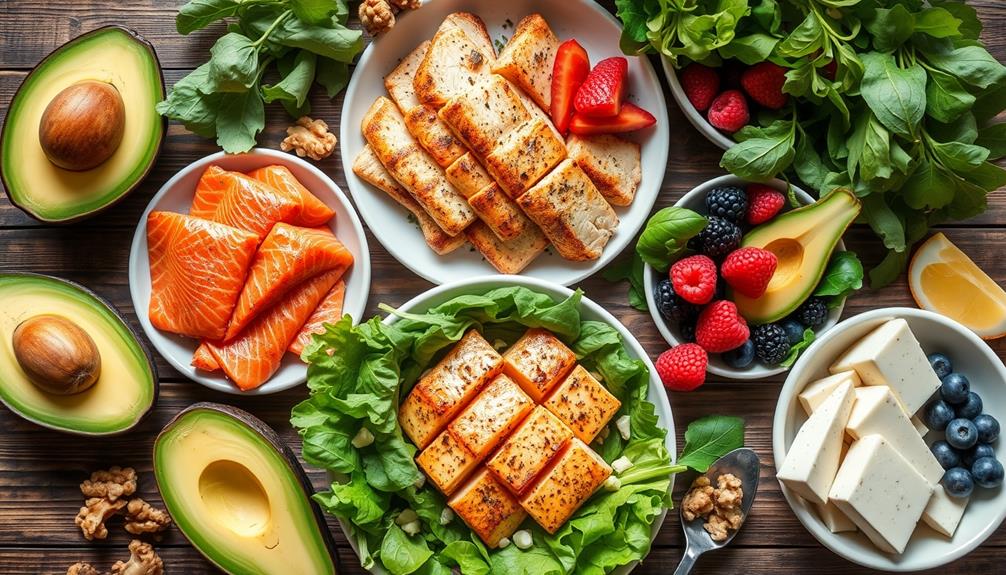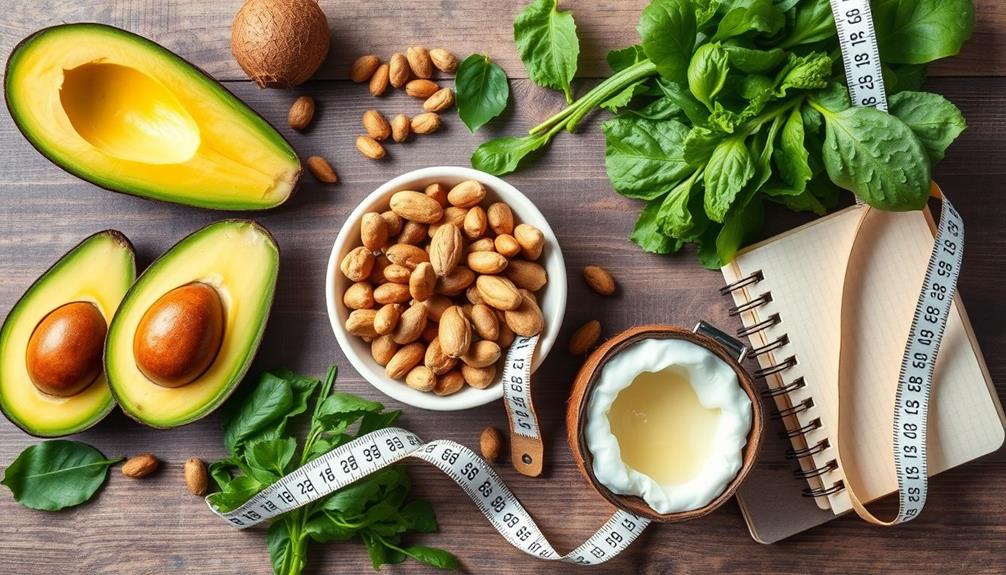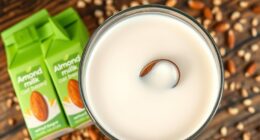To start your keto diet plan, aim for a high-fat, low-carb approach, with about 70-75% of your calories coming from healthy fats, 20-25% from proteins, and only 5-10% from carbohydrates. Limit your daily carb intake to less than 20-50 grams. Focus on foods like avocados, olive oil, eggs, and low-carb vegetables like spinach and broccoli. Meal planning is essential; create a shopping list of keto-friendly staples and keep high-fat snacks handy. Stay hydrated and manage possible "keto flu" symptoms as your body adjusts. Stick around for tips to help you stay on track and succeed in the long run.
Key Takeaways
- Understand the macronutrient breakdown: aim for 70-75% fats, 20-25% protein, and 5-10% carbohydrates, limiting carbs to under 20 grams daily.
- Create a meal plan focusing on high-fat foods and low-carb vegetables to maintain your carb intake below 20-50 grams.
- Stock up on keto-friendly foods like avocados, olive oil, fatty meats, and low-carb vegetables while avoiding grains and sugars.
- Prepare keto snacks, such as cheese, nuts, and hard-boiled eggs, to manage hunger between meals and stay on track.
- Monitor potential side effects like "keto flu" and nutrient deficiencies, and consider regular cholesterol checks for long-term adherence.
Understanding the Keto Diet

Understanding the Keto Diet involves grasping the fundamental change in how your body fuels itself. Following a Keto Diet Plan means adopting a high-fat, low-carbohydrate eating style, typically consisting of 70-75% fats, 20-25% protein, and only 5-10% carbohydrates. This macronutrient ratio encourages your body to enter a state called ketosis, where it burns fat instead of glucose for energy.
Additionally, incorporating foods rich in antioxidants, such as celery juice, can support your overall health during this dietary alteration.
To shift into ketosis, you'll need to limit your daily net carbohydrate intake to less than 20 grams. By doing this, your body starts to utilize its fat stores, converting fats into ketones through your liver. These ketones become an alternative energy source for both your brain and body when glucose isn't readily available.
Originally formulated in the 1920s to treat epilepsy, the ketogenic diet has recently gained popularity for its potential in rapid weight loss and better blood sugar control, especially for individuals with type 2 diabetes.
However, during the initial weeks, you might experience some common side effects known as "keto flu," including fatigue and headaches, as your body adjusts to this new metabolic state.
Benefits of the Keto Diet

Adopting a Keto Diet not only helps your body shift into ketosis but also offers a range of benefits that can enhance your overall well-being. Many people experience significant initial weight loss, often more pronounced than with balanced diets, thanks to increased fat burning and appetite suppression. This can be a great boost for your weight loss goals.
Additionally, incorporating a proper understanding of cold medications can further enhance your health as you adjust to new dietary habits.
If you have type 2 diabetes, you may find improved blood sugar control, as around 60% of patients on the Keto Diet have reported positive changes. In some cases, individuals have even reversed their condition. You might also notice higher energy levels and enhanced mental clarity, as your body efficiently utilizes ketones from fat for fuel.
Additionally, the Keto Diet may improve your cholesterol levels, reducing triglycerides and increasing HDL cholesterol, which contributes to better heart health.
For those dealing with epilepsy, especially cases resistant to traditional treatments, research indicates a potential reduction in seizure frequency. Overall, the health benefits of the Keto Diet can be transformative, making it a compelling option for many.
Potential Risks and Considerations

Starting a Keto Diet can bring about several potential risks and considerations that you should be aware of. One common issue is the "keto flu," which can hit you with symptoms like fatigue, headache, nausea, and irritability as your body shifts into ketosis. This typically lasts from a few days to a week, but it can be uncomfortable.
To support your body during this shift, consider incorporating essential oils known for their calming properties, such as lavender oil, which may help alleviate stress and discomfort.
Another concern is nutrient deficiencies. Since the keto diet restricts food variety, you may not get enough vitamins and minerals unless you plan your meals carefully. It's important to include low-carb, high-fiber options to help with digestive health, as some people experience constipation or diarrhea from reduced fiber intake.
Additionally, long-term adherence to the keto diet may elevate cholesterol levels in some individuals. Regular monitoring of your cholesterol is necessary to guarantee it stays within a healthy range.
Macronutrient Breakdown

Achieving success on a ketogenic diet hinges on mastering the macronutrient breakdown that fuels ketosis. To enter and maintain this fat-burning state, you should focus on a macronutrient ratio of about 70-75% healthy fats, 20-25% proteins, and only 5-10% carbohydrates. This specific breakdown is essential for effective ketosis, especially when considering effective strategies for weight loss that can complement your dietary changes.
Your carbohydrate intake needs to be tightly controlled, aiming for less than 20-50 grams of net carbs per day. This limitation encourages your body to switch from using carbs for energy to burning fat instead.
To achieve this, prioritize healthy fats in your meals. Incorporate sources like avocados, nuts, seeds, and oils such as olive and coconut oil. These foods not only provide essential nutrients but also keep you feeling satiated.
Protein intake should be moderate, making up around 15-20% of your total calories. Be cautious with protein, as consuming too much can convert to glucose, which may hinder your entry into ketosis.
Meal Planning Strategies

Once you've got a grasp on the macronutrient breakdown, effective meal planning becomes your next focus in the keto journey. A well-structured meal plan is vital to keep your daily carb intake below 20-50 grams while emphasizing high-fat foods.
Aim for meals that adhere to the recommended macronutrient ratio of 70-75% fats, 20-25% protein, and 5-10% carbohydrates. Understanding common financial terms can also help you budget for any new ingredients or specialty items you might want to try. Consider creating a two-week meal plan with specific recipes that meet these requirements, making your keto shift smoother.
Preparing a shopping list is important for ensuring you stock up on keto-friendly staples. Include items like meats, eggs, dairy, and low-carb vegetables to streamline your grocery trips and avoid impulse buys of high-carb foods.
Utilizing meal prep techniques can further simplify your keto lifestyle. Cook larger portions or whip up no-cook meals to stay on track, especially during busy days.
Keep keto-friendly snacks like hard-boiled eggs, cheese, and nuts handy to help manage hunger between meals. This way, you'll be less tempted to stray from your meal plans and stay committed to your ketogenic goals.
Shopping List Essentials

A well-curated shopping list is your key to successfully steering the keto diet. Start by prioritizing high-fat foods like avocados, olive oil, coconut oil, and fatty cuts of meat. These items help you meet the macronutrient goals of 70-75% fat fundamental for a high-fat diet.
Additionally, understanding the financial aspects of meal planning can be beneficial for maintaining your budget while sticking to the diet, especially if you consider financial considerations for elderly care when planning meals.
Next, include low-carb vegetables such as spinach, kale, broccoli, and cauliflower. These are vital for obtaining necessary nutrients while keeping your carb counts low.
Don't forget protein sources like eggs, poultry, beef, and fatty fish like salmon, which guarantee you get adequate protein without exceeding your carb limits.
To help manage hunger between meals, stock up on keto-friendly snacks such as nuts, seeds, cheese, and hard-boiled eggs. These snacks not only keep you satisfied but also align with your dietary goals.
Keto-Friendly Foods

When you're starting the keto diet, it's essential to focus on the right foods. Incorporating healthy fats, low-carb vegetables, and quality protein sources won't only keep your body in ketosis but can also enhance your overall wellness.
Additionally, understanding the impact of different food types on your health can provide greater insights into your dietary choices, much like how various brewing methods affect caffeine content markedly.
Let's explore these keto-friendly options that will help you stay on track.
Healthy Fats Selection
Choosing the right healthy fats is essential to making your keto diet successful. Healthy fats should make up at least 60% of your daily caloric intake, so focus on high-quality sources.
Olive oil is a versatile option that can be used for cooking or drizzling on salads. Avocado oil and coconut oil are also fantastic choices for their unique flavor profiles and health benefits. Additionally, incorporating herbal teas like chamomile and ginger can promote relaxation and complement your dietary efforts.
Incorporating fatty fish like salmon and mackerel into your meals not only boosts your healthy fat intake but also provides essential omega-3 fatty acids, promoting heart health and reducing inflammation.
For snacks, consider nuts and seeds like macadamia nuts, chia seeds, and flaxseeds, which balance healthy fats with fiber and protein.
Don't forget about dairy products! Cheese, heavy cream, and full-fat yogurt are rich in healthy fats and can add flavor and satiety to your keto meals.
However, steer clear of trans fats and highly processed oils, as they can undermine your efforts. By choosing whole food sources of fat, you'll maintain nutrient density and support overall health while following a ketogenic diet.
Low-Carb Vegetables Choices
Incorporating low-carb vegetables into your keto meal plan is a smart way to enhance your diet while keeping your carb intake in check. Individuals with certain mental health challenges, such as BPD symptoms, may benefit from a balanced diet that includes these nutritious options.
Leafy greens like spinach, kale, and arugula are fantastic options, each containing fewer than 5 grams of net carbs per 100 grams. They're packed with essential nutrients and can easily be tossed into salads or smoothies.
Cruciferous vegetables such as broccoli, cauliflower, and Brussels sprouts also shine in the keto diet, offering about 4-6 grams of net carbs per 100 grams while providing fiber and vitamins.
Zucchini is another versatile choice; it can be spiralized into noodles and has around 3 grams of net carbs per 100 grams, making it a great pasta substitute.
Don't forget about bell peppers, especially green ones, which have approximately 3 grams of net carbs per 100 grams and are rich in vitamins A and C.
Finally, mushrooms are a low-carb gem, with about 2-4 grams of net carbs per 100 grams, adding both flavor and texture to your dishes.
Embrace these low-carb vegetables to keep your keto diet delicious and satisfying!
Protein Sources Overview
A well-rounded keto diet relies heavily on high-quality protein sources to fuel your body while keeping carbs low. Incorporating meats like beef, pork, and poultry is a great way to get essential amino acids without exceeding your carbohydrate limits.
Fatty fish such as salmon and mackerel are also excellent choices, offering not just protein but heart-healthy omega-3 fatty acids that enrich your intake of healthy fats. Additionally, ensuring your diet includes safe snack options can enhance your meal variety and enjoyment, similar to how safe snacks for hamsters can contribute to their well-being.
Eggs stand out as a versatile and affordable protein source, packed with healthy fats, vitamins, and minerals, making them a staple in many keto meal plans.
When it comes to dairy, opt for full-fat varieties like cheese, Greek yogurt, and heavy cream, as they provide both protein and fats aligned with keto macronutrient goals.
If you're leaning toward a vegetarian approach, plant-based protein sources like tofu and tempeh can fit into your plan, but remember to consume them in moderation to maintain ketosis.
Managing Keto Flu Symptoms

Steering through the early days of a ketogenic diet can be challenging, especially when you experience the so-called "keto flu."
Symptoms like fatigue, headache, and irritability often arise as your body adapts to burning fat instead of carbohydrates. To help manage these symptoms, focus on hydration and electrolyte balance.
Here are four tips to ease your adjustment:
- Stay Hydrated: Drink plenty of water to combat dehydration and alleviate symptoms. Aim for at least 8-10 glasses a day.
- Increase Electrolytes: Boost your sodium, potassium, and magnesium intake through foods like avocados, leafy greens, and nuts or consider supplements to prevent electrolyte imbalance.
- Gradual Carb Reduction: Instead of drastically cutting carbs, reduce them gradually over a week. This can minimize the severity of keto flu symptoms.
- Rest and Light Exercise: Incorporate light physical activities, like walking, while ensuring you get enough rest to support your body's adjustment.
Tips for Long-Term Success

To succeed on the keto diet long-term, you'll want to establish a solid meal prep routine that keeps you stocked with keto-friendly meals.
Monitoring your macronutrient intake and staying hydrated are also vital for maintaining your energy and health.
Meal Prep Essentials
Meal prep is a game changer for anyone starting on a keto diet. By planning and preparing your meals in advance, you'll guarantee that you always have keto-friendly options ready to go.
Dedicate a specific day each week to cook large batches of meals, and you'll reduce the temptation to stray from your diet.
Here are four meal prep essentials to keep in mind:
- Storage Containers: Use a variety of containers to keep your prepped meals fresh. This makes it easy to grab a meal or snack without extra effort.
- Nutritional Balance: Focus on incorporating proteins, healthy fats, and low-carb vegetables into your meals to maintain flavor and variety.
- Keto Staples: Keep a well-stocked pantry with essentials like coconut oil, olive oil, nuts, seeds, and low-carb condiments. These will simplify cooking and enhance your meals.
- Experimentation: Dedicate time each week to try new recipes. This keeps your meal prep exciting and aligned with your dietary goals.
With these essentials, you'll set yourself up for long-term success on your keto journey!
Monitor Macronutrient Intake
Successfully meal prepping sets a strong foundation for your keto journey, but monitoring your macronutrient intake is key to maintaining long-term success. Aim for a macronutrient ratio of about 70-75% fats, 20-25% protein, and 5-10% carbs. Keep your daily carb intake below 20-50 grams to stay in ketosis.
Using food tracking apps or journals can help you accurately monitor your macronutrient intake. Focus on whole, unprocessed foods like meats, eggs, avocados, and low-carb veggies to provide essential nutrients while keeping carb counts low. Regularly reassess your targets based on personal goals and how your body responds.
Consider incorporating periodic blood ketone testing to confirm you're in a state of ketosis. Here's a quick overview of macronutrient sources:
| Macronutrient | Examples |
|---|---|
| Fats | Avocados, Olive Oil |
| Proteins | Chicken, Eggs |
| Carbs | Leafy Greens, Berries |
| Whole Foods | Nuts, Seeds |
| Adjustments | Personal Goals |
Stay Hydrated Regularly
Staying hydrated is essential for your success on the keto diet, especially since cutting back on carbs can lead to increased water loss.
To maintain ideal hydration levels and support your overall health, aim for 6-8 glasses of water daily, or more if you're active.
Here are some tips to help you stay hydrated:
- Drink before meals: This can help with appetite control, making it easier to manage your calorie intake.
- Monitor signs of dehydration: Look out for dizziness, dry mouth, and fatigue—these can hinder your ability to stick to the diet.
- Incorporate electrolyte-rich fluids: Consider broth or adding salt to your meals to maintain electrolyte balance, which can help prevent symptoms of the "keto flu."
- Use hydration aids: Sparkling water or herbal teas can enhance fluid intake while keeping you within keto principles.
Resources for Support and Guidance

When you're diving into the Keto Diet, having the right resources can make all the difference in your journey. Reputable healthcare organizations like the Cleveland Clinic and Mayo Clinic offer expert guidelines that provide structured information for beginners.
Johns Hopkins Medicine also has extensive guides focusing on the ketogenic diet's therapeutic effects, especially for conditions like epilepsy and diabetes.
Online forums and support groups are invaluable for connecting with others on similar dietary journeys. They enhance motivation and adherence by sharing experiences and practical tips.
Additionally, Familydoctor.org offers practical advice for beginners, including meal planning and common pitfalls to avoid, ensuring a smoother shift into the diet.
You can also find various health tools and calculators online to help you track macronutrient intake and monitor your progress.
These resources facilitate a more personalized approach to the Keto Diet, allowing you to stay aligned with your goals.
With the right support and guidance, you'll feel empowered to navigate your Keto journey successfully, making it easier to maintain a healthy lifestyle that suits you.
Frequently Asked Questions
How Do I Start My Keto Diet for the First Time?
To start your keto diet, calculate your macronutrient needs, focus on high-fat foods, eliminate carbs, and prepare for initial symptoms. Plan meals, track intake, and monitor progress to effectively shift into ketosis. Adhering to a keto diet plan can be challenging at first, but with careful planning and dedication, many people find success in reaching their health and weight loss goals. It’s important to stay disciplined and stay mindful of your food choices, avoiding any high-carb foods that can kick you out of ketosis. Remember that the keto diet is not just a temporary fix, but rather a long-term lifestyle change that can have a positive impact on your overall well-being. With determination and the right resources, you can make the transition to a keto diet plan as seamless as possible.
What Is a Keto Diet Plan for Beginners?
Did you know that about 60% of people experience weight loss on a keto diet? A beginner's plan focuses on low carbs, high fats, and whole foods, ensuring you stay healthy while entering ketosis effectively.
How Do Beginners Get Into Ketosis?
To get into ketosis, you'll need to cut carbs drastically, increase healthy fats, and stay hydrated. Regular exercise helps, too. Tracking your food intake guarantees you maintain the right balance for successful ketosis.
What Are the 9 Rules of Keto?
Did you know that around 60% of Americans struggle with weight management? To succeed on keto, follow these nine rules: limit carbs, increase healthy fats, moderate protein, stay hydrated, maintain electrolytes, and plan your meals carefully.
Conclusion
Starting your keto journey is like setting sail on a culinary adventure, where each meal is a treasure chest of flavors waiting to be discovered. By embracing the low-carb lifestyle, you'll not only shed unwanted pounds but also reveal newfound energy and liveliness. Remember, every step counts, so stay committed and be kind to yourself. With the right planning and support, you'll navigate the seas of ketosis with confidence, turning your dreams of health into reality.









